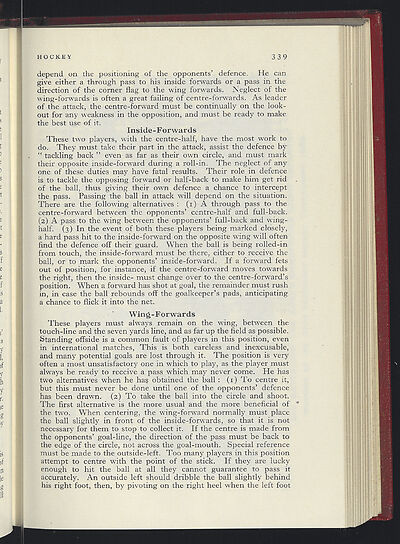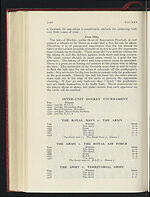1938-39
(365)
Download files
Complete book:
Individual page:
Thumbnail gallery: Grid view | List view

i
HOCKEY
depend on the positioning of the opponents' defence. He can
give either a through pass to his inside forwards or a pass in the
direction of the corner flag to the wing forwards. Neglect of the
wing-forwards is often a great failing of centre-forwards. As leader
of the attack, the centre-forward must be continually on the look-
out for any weakness in the opposition, and must be ready to make
the best use of it.
Inside
-
Forwards
These two players, with the centre-half, have the most work to
do. They must take their part in the attack, assist the defence by
" tackling back " even as far as their own circle, and must mark
their opposite inside-forward during a roll-in. The neglect of any
one of these duties may have fatal results. Their role in defence
is to tackle the opposing forward or half-back to make him get rid
of the ball, thus giving their own defence a chance to intercept
the pass. Passing the ball in attack will depend on the situation.
There are the following alternatives : (i) A through pass to the
centre-forward between the opponents' centre-half and full-back.
(z) A pass to the wing between the opponents' full-back and wing-
half. (3) In the event of both these players being marked closely,
a hard pass hit to the inside-forward on the opposite wing will often
find the defence off their guard. When the ball is being rolled-in
from touch, the inside-forward must be there, either to receive the
ball, or to mark the opponents' inside-forward. If a forward fets
out of position, for instance, if the centre-forward moves towards
the right, then the inside- must change over to the centre-forward's
position. When a forward has shot at goal, the remainder must rush
in, in case the ball rebounds off the goalkeeper's pads, anticipating
a chance to flick it into the net.
Wing-Forwards
These players must always remain on the wing, between the
touch-line and the seven yards line, and as far up the field as possible.
Standing offside is a common fault of players in this position, even
in international matches, This is both careless and inexcusable,
and many potential goals are lost through it. The position is very
often a most unsatisfactory one in which to
play,
as the player must
always be ready to receive a pass which may never come. He has
two alternatives when he has obtained the ball : (i) To centre it,
but this must never be done until one of the opponents' defence
has been drawn. (z) To take the ball into the circle and shoot.
The first alternative is the more usual and the more beneficial of
the two. When centering, the wing-forward normally must place
the ball slightly in front of the inside-forwards, so that it is not
necessary for them to stop to collect it. If the centre is made from
the opponents' goal-line, the direction of the pass must be back to
the edge of the circle, not across the goal-mouth. Special reference
must be made to the outside-left. Too many players in this position
attempt to centre with the point of the stick. If they are lucky
enough to hit the ball at all they cannot guarantee to pass it
accurately. An outside left should dribble the ball slightly behind
his right foot, then, by pivoting on the right heel when the left foot
HOCKEY
depend on the positioning of the opponents' defence. He can
give either a through pass to his inside forwards or a pass in the
direction of the corner flag to the wing forwards. Neglect of the
wing-forwards is often a great failing of centre-forwards. As leader
of the attack, the centre-forward must be continually on the look-
out for any weakness in the opposition, and must be ready to make
the best use of it.
Inside
-
Forwards
These two players, with the centre-half, have the most work to
do. They must take their part in the attack, assist the defence by
" tackling back " even as far as their own circle, and must mark
their opposite inside-forward during a roll-in. The neglect of any
one of these duties may have fatal results. Their role in defence
is to tackle the opposing forward or half-back to make him get rid
of the ball, thus giving their own defence a chance to intercept
the pass. Passing the ball in attack will depend on the situation.
There are the following alternatives : (i) A through pass to the
centre-forward between the opponents' centre-half and full-back.
(z) A pass to the wing between the opponents' full-back and wing-
half. (3) In the event of both these players being marked closely,
a hard pass hit to the inside-forward on the opposite wing will often
find the defence off their guard. When the ball is being rolled-in
from touch, the inside-forward must be there, either to receive the
ball, or to mark the opponents' inside-forward. If a forward fets
out of position, for instance, if the centre-forward moves towards
the right, then the inside- must change over to the centre-forward's
position. When a forward has shot at goal, the remainder must rush
in, in case the ball rebounds off the goalkeeper's pads, anticipating
a chance to flick it into the net.
Wing-Forwards
These players must always remain on the wing, between the
touch-line and the seven yards line, and as far up the field as possible.
Standing offside is a common fault of players in this position, even
in international matches, This is both careless and inexcusable,
and many potential goals are lost through it. The position is very
often a most unsatisfactory one in which to
play,
as the player must
always be ready to receive a pass which may never come. He has
two alternatives when he has obtained the ball : (i) To centre it,
but this must never be done until one of the opponents' defence
has been drawn. (z) To take the ball into the circle and shoot.
The first alternative is the more usual and the more beneficial of
the two. When centering, the wing-forward normally must place
the ball slightly in front of the inside-forwards, so that it is not
necessary for them to stop to collect it. If the centre is made from
the opponents' goal-line, the direction of the pass must be back to
the edge of the circle, not across the goal-mouth. Special reference
must be made to the outside-left. Too many players in this position
attempt to centre with the point of the stick. If they are lucky
enough to hit the ball at all they cannot guarantee to pass it
accurately. An outside left should dribble the ball slightly behind
his right foot, then, by pivoting on the right heel when the left foot
Set display mode to:
![]() Universal Viewer |
Universal Viewer | ![]() Mirador |
Large image | Transcription
Mirador |
Large image | Transcription
| Games and sports in the army > 1938-39 > (365) |
|---|
| Permanent URL | https://digital.nls.uk/248741351 |
|---|
| Description | 'Games and Sports in the Army' was an annual publication produced by the British War Office between the 1930s and 1960s. This included the Second World War. It outlines the rules and regulations for games and sports played by members of the armed forces. It features names and photographs of team members, and examples of contemporary advertising. |
|---|---|
| Shelfmark | GWB.52 |

